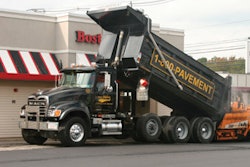In the big picture, John has a good pavement maintenance company. He's hard working, has a normal mix of long-term and short-term workers, but he can't quite seem to break through the profitability ceiling, or "PC." As much as he works and re-works his estimating efforts he still is falling 3%, 5%, even 9% short of the gross profit that he should be realizing on most jobs. His frustrations led to his asking me to come alongside for the rest of this year to get him over the "PC" barrier.
Too many good contractors are struggling today with getting that next 3%-5% of gross profit. Some contractors are literally approaching double-digit shortages from what they should be experiencing on their gross profit. After reviewing the work processes of John's crews I'm convinced that he can realize greater gross profit - but it's going to take planning, execution, and commitment.
First, most pavement maintenance contractors do a horrible job of pre-planning their projects. Preplanning, especially preconstruction, is a specialized effort among general contractors and our industry could learn much from them.
Preconstruction, with an emphasis on preplanning, begins when a field leader takes the collected information from the estimate and reviews what he and his crew can do to maximize the production effort. This means recognizing where trucks, equipment, materials, etc. should be delivered, loaded, unloaded, and stored. When not done this can cost a contractor thousands of dollars a year in accidents and damaged materials.
Second, set out the next week's schedule by each Friday. Many years ago I introduced the "Next Week Look Ahead" to our industry at our annual conferences. The contractors who have embraced this tool confidently share that this process of planning will add 2%-4% almost immediately to their gross profit, often more. The big objection I hear for not doing this is that "the schedule will always change." The schedule does change periodically, but by having the plan in place the alternative decisions can be made faster and with more foresight. There is absolutely no excuse for not planning!
Third, there needs to be an organized process to unload, place, store, and load equipment, tools, materials, etc. This can also be preplanned by creating something Japanese Management has called "5-S." There are five components involved with incorporating 5-S but one effort that is critical for us here is the development of a 5-S Map.
A 5-S Map can be used for many purposes that will help to keep things organized and encourage a cleaner and safer job, jobsite, yard, shop and even better-organized trucks. Consider an aerial drawing of the inside of your tool truck. Once drawn, you then identify where each item is to be kept. You can do this by drawing an arrow to the location on the truck where the item is to be kept and then writing what the item is.
In addition to developing a 5-S Map for your truck, shop, and yard you should develop one for how you want to lay out equipment and tools at a jobsite. Some contractors argue with me but soon realize how much they can save by having all the items that they will be using lined out or positioned on a job site for faster retrieval and better handling.
Fourth, the leadership to hold morning and afternoon "huddles" between a crew leader and the crew members is crucial for successful production each day. This huddle is a brief 3- to 5-minute meeting at the jobsite that clarifies what the targets are for the day, confirms who is doing what on the job, and reminds workers of important information about the job and safety reminders. This morning huddle isn't enough; there needs to be a "PM" huddle just before all the workers head home or back to the yard. The afternoon huddle reviews what happened during the day, what can be improved, and what can be done to make the next day's production go faster and smoother.
Finally, the most critical issue to busting through your profitability ceiling is to be a driver of the first four items. If you clearly communicate what the new standards and expectations are and then back it up with enforcement when needed you will find busting through the profitability ceiling not only possible but...well, extremely profitable!



















